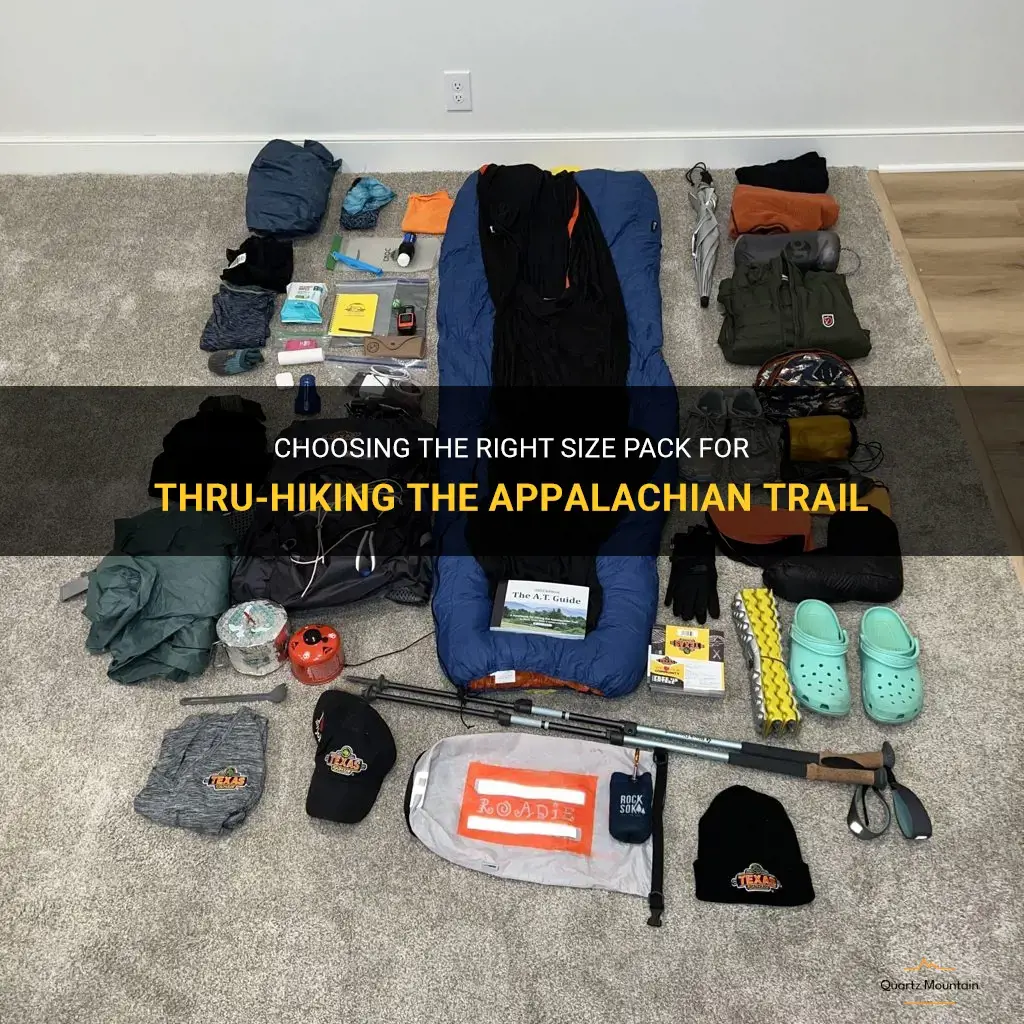
Embarking on a thru-hike of the Appalachian Trail is no small feat, and choosing the right gear is a crucial part of ensuring a successful journey. Among the most important decisions is selecting the right size pack. While it may seem like a simple choice, the size of your pack can greatly impact your comfort, convenience, and overall experience on the trail. In this article, we will explore the factors to consider when choosing the right size pack for thru-hiking the Appalachian Trail, and offer some tips to help you make the best decision for your adventure.
What You'll Learn
- What factors should I consider when determining what size pack to use for a thru-hike of the Appalachian Trail?
- What is the ideal volume range for a backpack for a thru-hike of the Appalachian Trail?
- How do I determine what gear and supplies I will need to carry in my pack for a thru-hike of the Appalachian Trail?
- Are there specific pack features that are recommended for a thru-hike of the Appalachian Trail?
- Are there any recommended pack brands or models that are popular among thru-hikers of the Appalachian Trail?

What factors should I consider when determining what size pack to use for a thru-hike of the Appalachian Trail?
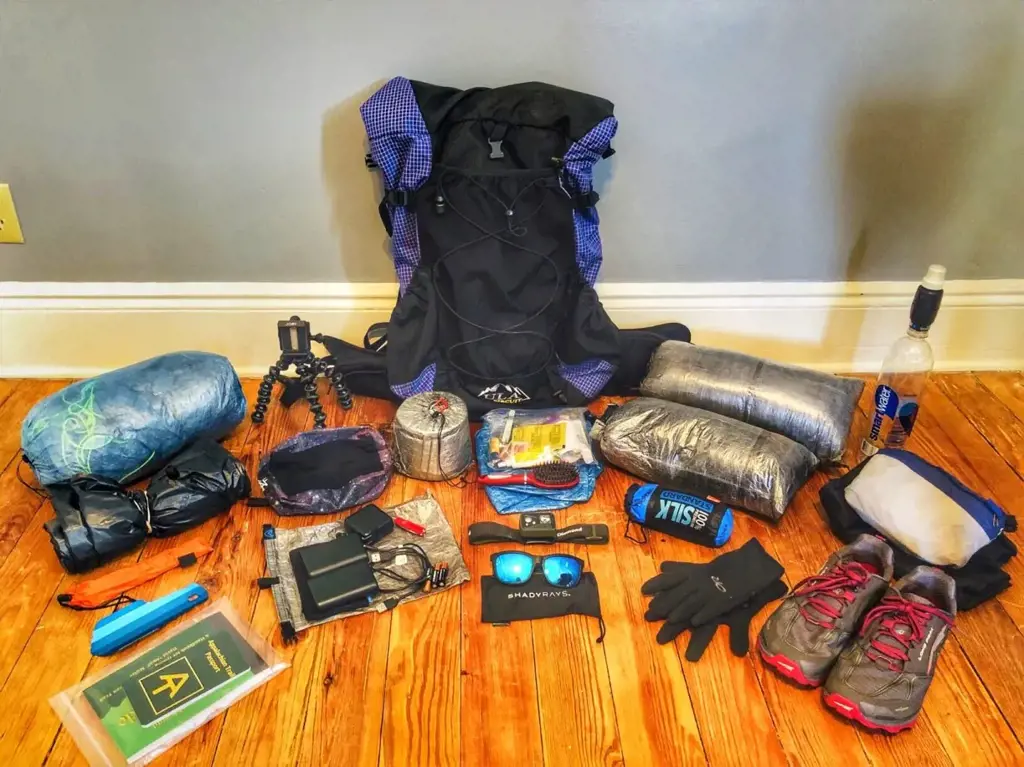
When embarking on a thru-hike of the Appalachian Trail, choosing the right pack size is crucial. The pack you choose will determine how much gear you can bring with you and how comfortable and manageable your hike will be. There are several factors to consider when determining what size pack to use for a thru-hike of the Appalachian Trail, such as the length of your hike, the amount of gear you plan to carry, and your personal preferences and comfort.
Firstly, the length of your thru-hike will play a significant role in determining the size of your pack. If you plan on completing the entire Appalachian Trail in one go, which spans approximately 2,200 miles, you will likely need a larger pack to accommodate all the necessary gear and supplies. On the other hand, if you are only planning on hiking a portion of the trail, such as a few weeks or a few hundred miles, a smaller pack may be more suitable. Consider how long you will be on the trail and how much gear you will need to carry for that duration.
Next, take into account the amount of gear you plan to carry. Thru-hikers typically need to carry a sleeping bag, a shelter (such as a tent or tarp), cooking equipment, clothing, food, water, and personal items. The size and weight of your gear will determine how much space you will need in your pack. If you have lightweight and compact gear, you may be able to get away with a smaller pack. However, if you have bulkier or heavier gear, you will likely need a larger pack to accommodate everything.
Consider your personal preferences and comfort as well. Some hikers prefer to carry a lighter load and opt for a smaller pack, while others prefer to have a little more space and choose a larger pack. Think about how comfortable you are with carrying a heavier load and how much extra space you would like to have for additional items or comforts. Keep in mind that a larger pack may also be bulkier and more cumbersome to carry, so consider your strength and endurance levels.
Additionally, it can be helpful to consult experienced hikers or seek advice from outdoor gear specialists. They can provide insights based on their own experiences and offer recommendations based on your specific needs and preferences. They may be able to suggest specific pack sizes or brands that are well-suited for thru-hiking the Appalachian Trail.
To illustrate the significance of pack size, let's consider an example. Mary is planning a thru-hike of the Appalachian Trail and expects to complete it in four months. She has lightweight and compact gear and prefers to carry a lighter load. After consulting experienced hikers and outdoor gear specialists, she decides to go with a 40-liter pack. This size allows her to comfortably fit all her gear and supplies while keeping her pack weight at a manageable level. Mary's choice of a smaller pack size aligns with her personal preferences and the duration of her hike.
In conclusion, choosing the right pack size for a thru-hike of the Appalachian Trail requires careful consideration of the length of your hike, the amount of gear you plan to carry, and your personal preferences and comfort. By taking these factors into account and seeking advice from experienced hikers, you can find the perfect pack size that will make your thru-hike a comfortable and enjoyable experience.
Essential Items to Pack for Your University Center Chicago Journey
You may want to see also

What is the ideal volume range for a backpack for a thru-hike of the Appalachian Trail?
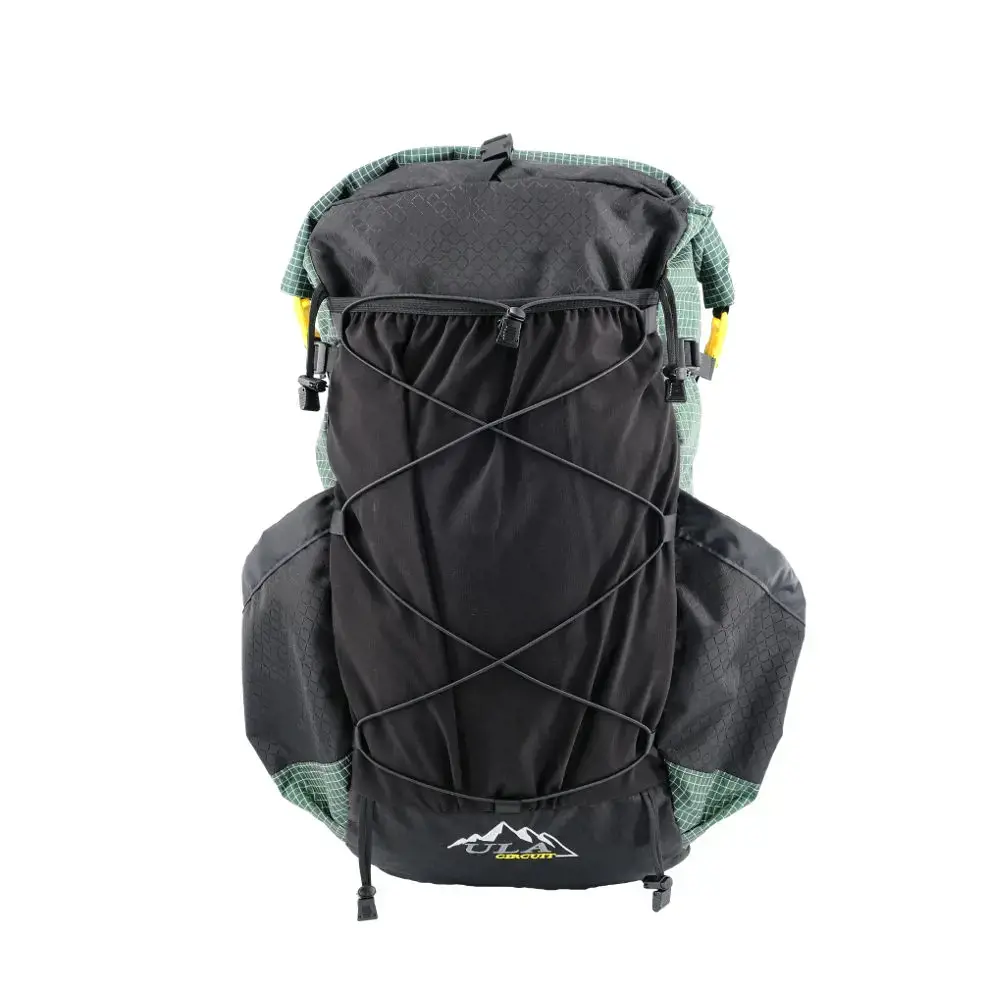
The Appalachian Trail is a 2,200-mile long-distance hiking trail that stretches from Georgia to Maine. Thru-hiking the Appalachian Trail is a grueling undertaking that requires careful planning and preparation. One of the most important decisions a hiker must make is choosing the right backpack. The ideal volume range for a backpack for a thru-hike of the Appalachian Trail can vary depending on a variety of factors, including personal preference, gear selection, and trip length.
When considering the ideal volume range for a backpack, it's important to take into account the amount of gear and supplies that will be carried on the hike. Thru-hikers typically carry a tent, sleeping bag, sleeping pad, cooking equipment, food, water, clothing, and other essential items. These items can add up quickly and take up a significant amount of space in a backpack.
While some hikers prefer to carry a larger backpack to accommodate all of their gear, others opt for a smaller, more lightweight pack to minimize weight and maximize mobility. The ideal volume range for a backpack for a thru-hike of the Appalachian Trail typically falls between 40 and 60 liters. This range allows hikers to comfortably carry all of their gear while still maintaining a manageable weight.
Choosing a backpack within this volume range requires careful consideration of the specific gear and supplies that will be carried on the hike. Hikers should take into account the size and weight of their tent, sleeping bag, and other gear when selecting a backpack. Additionally, the length of the hike should be considered when determining the appropriate volume range. Longer trips may require a larger backpack to accommodate additional food and supplies.
It's also important to consider personal preferences when selecting a backpack for a thru-hike of the Appalachian Trail. Some hikers prefer a more minimalist approach and are able to carry all of their gear in a smaller, lightweight pack. Others prefer to have more space and opt for a larger, more feature-rich backpack. Ultimately, the ideal volume range for a backpack will depend on the individual hiker and their specific needs and preferences.
In order to determine the ideal volume range for a backpack, it's helpful to consult with experienced thru-hikers and outdoor gear experts. These individuals can provide valuable insights and recommendations based on their own experiences and the experiences of others. Additionally, it's a good idea to try on and test out different backpacks before making a final decision. This will allow hikers to assess the fit, comfort, and functionality of different backpack models and determine which one is the best fit for their needs.
In conclusion, the ideal volume range for a backpack for a thru-hike of the Appalachian Trail typically falls between 40 and 60 liters. However, the specific volume range will vary depending on factors such as personal preference, gear selection, and trip length. By carefully considering these factors and consulting with experienced hikers and gear experts, hikers can choose the right backpack to ensure a successful and enjoyable thru-hike of the Appalachian Trail.
Essential Items to Pack for Your Trip to Oman
You may want to see also

How do I determine what gear and supplies I will need to carry in my pack for a thru-hike of the Appalachian Trail?
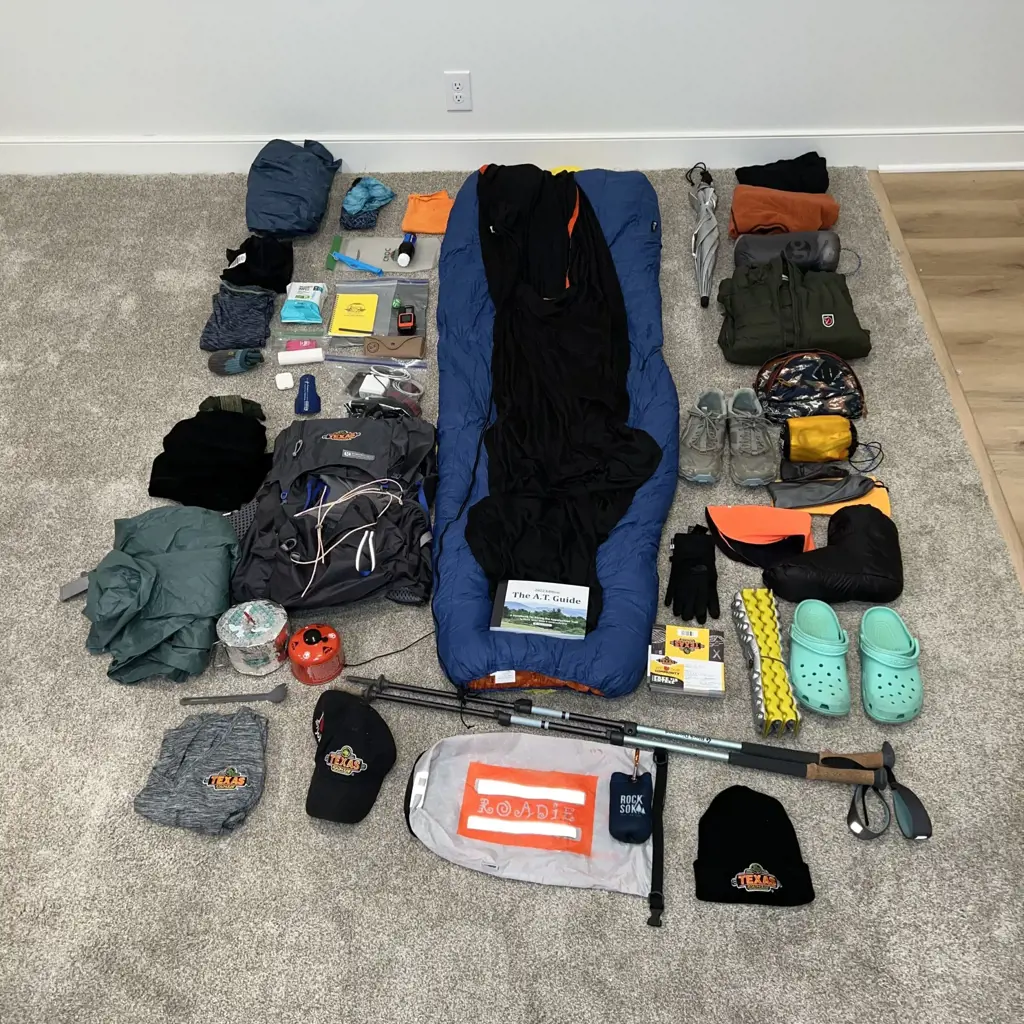
If you are embarking on a thru-hike of the Appalachian Trail, it is crucial to carefully consider the gear and supplies you will need to carry in your pack. The Appalachian Trail spans 2,190 miles and passes through a variety of terrains and climates, making proper gear selection essential for a successful hike. Here are some steps to help you determine what gear and supplies to carry on your thru-hike:
Step 1: Research the Trail
Before setting out on the Appalachian Trail, it is essential to thoroughly research the trail. This includes studying the terrain, climate, and potential hazards you may encounter along the way. By understanding the trail's characteristics, you can better determine the necessary gear and supplies for your hike.
Step 2: Consider the Seasons and Weather
The Appalachian Trail experiences a wide range of weather conditions throughout the year. It is important to pack gear suitable for the specific season you plan to hike. For example, a lightweight sleeping bag might be sufficient for a summer hike, while a warmer sleeping bag and insulation layers would be necessary for a winter hike. Additionally, it's crucial to bring rain gear, such as a waterproof jacket and pants, as rain is common along the trail.
Step 3: Weigh the Pros and Cons
When selecting gear and supplies for a thru-hike, it is essential to consider the weight and functionality of each item. Carrying unnecessary equipment will only add unnecessary weight to your pack and can become a burden over long distances. Research and invest in lightweight gear that still provides the necessary functions. For example, a lightweight, four-season tent and a compact stove can help you save on weight without sacrificing comfort and safety.
Step 4: Prioritize Comfort and Safety
While it is crucial to keep your pack light, it is equally important to prioritize comfort and safety. For a thru-hike on the Appalachian Trail, it is recommended to invest in a good-quality backpack that properly distributes weight and fits your body well. A comfortable sleeping pad and hiking boots that provide good support and fit well are also vital. Additionally, pack essentials like a first aid kit, headlamp, navigation tools, and a pocket knife to ensure your safety on the trail.
Step 5: Be Mindful of Hydration and Nutrition
Staying properly hydrated and fueled is crucial for any thru-hiker. Plan to carry a water filtration system or purification tablets to ensure you have access to clean water along the trail. It is also important to pack enough high-calorie, lightweight food to keep you energized during your hike. Trail mix, energy bars, dehydrated meals, and nuts are all popular choices among thru-hikers.
Step 6: Test and Adjust
Once you have gathered all the necessary gear and supplies, it is essential to test them before your thru-hike. Take short backpacking trips to gauge the functionality and comfort of your gear. This will give you an opportunity to adjust and replace any items that may not meet your needs.
By following these steps and taking into consideration the trail, weather conditions, weight, comfort, safety, and nutrition, you can determine the gear and supplies you will need to carry in your pack for a successful thru-hike of the Appalachian Trail. Remember, thorough research and preparation are key to an enjoyable and safe hiking experience.
Essential Items to Pack for Your Mexico City Adventure
You may want to see also

Are there specific pack features that are recommended for a thru-hike of the Appalachian Trail?

When embarking on a thru-hike of the Appalachian Trail, having a suitable backpack is essential. The right pack can make a tremendous difference in terms of comfort and functionality during the long journey. There are several specific pack features that are highly recommended for a successful thru-hike of the Appalachian Trail.
First and foremost, a lightweight pack is crucial. The Appalachian Trail covers a distance of over 2,000 miles, and every ounce counts when it comes to carrying your gear. Opting for a pack made from lightweight materials such as Dyneema or Cuben Fiber can significantly reduce the overall weight of your pack without compromising durability.
Another important feature to consider is a well-designed suspension system. The suspension system refers to the straps and padding that distribute the weight of the pack on your shoulders and hips. Look for a pack with well-padded shoulder straps, a fully adjustable hip belt, and a breathable back panel. A comfortable suspension system will help prevent discomfort and pain during long days on the trail.
Additionally, packs with a large carrying capacity are recommended for a thru-hike of the Appalachian Trail. The ability to carry all the necessary gear, including food and water, is crucial for an extended hike. Look for a pack with a capacity of at least 50 liters, with sufficient external pockets and straps for organizing and securing your gear.
Durability is another key factor to consider when choosing a pack. The Appalachian Trail can be rough and rugged, with various terrain and weather conditions. Opt for a pack made from high-quality materials and reinforced stitching. It's also a good idea to choose a pack from a reputable brand with a proven track record in the outdoor industry.
Lastly, consider the accessibility of your pack. Look for a pack with multiple entry points, such as a top-loading main compartment and side or front zippers. This will make it easier to access your gear without having to unpack everything each time.
To illustrate the importance of these pack features, let's consider an example. Imagine you're on a thru-hike of the Appalachian Trail, and you encounter a sudden downpour. Without a pack made from waterproof materials, your gear could get soaked, potentially ruining your trip. However, with a pack made from waterproof materials, you can have peace of mind knowing that your gear will stay dry.
In conclusion, when preparing for a thru-hike of the Appalachian Trail, it's crucial to choose a backpack with specific features to ensure comfort, functionality, and durability. Look for a lightweight pack with a well-designed suspension system, a large carrying capacity, and durability. Additionally, consider the accessibility of the pack to make it easier to access your gear when needed. By selecting a pack with these features, you'll be well-equipped for the challenges that lie ahead on your thru-hike of the Appalachian Trail.
The Essential Components of the 'Speak to Your Manager Starter Pack
You may want to see also

Are there any recommended pack brands or models that are popular among thru-hikers of the Appalachian Trail?
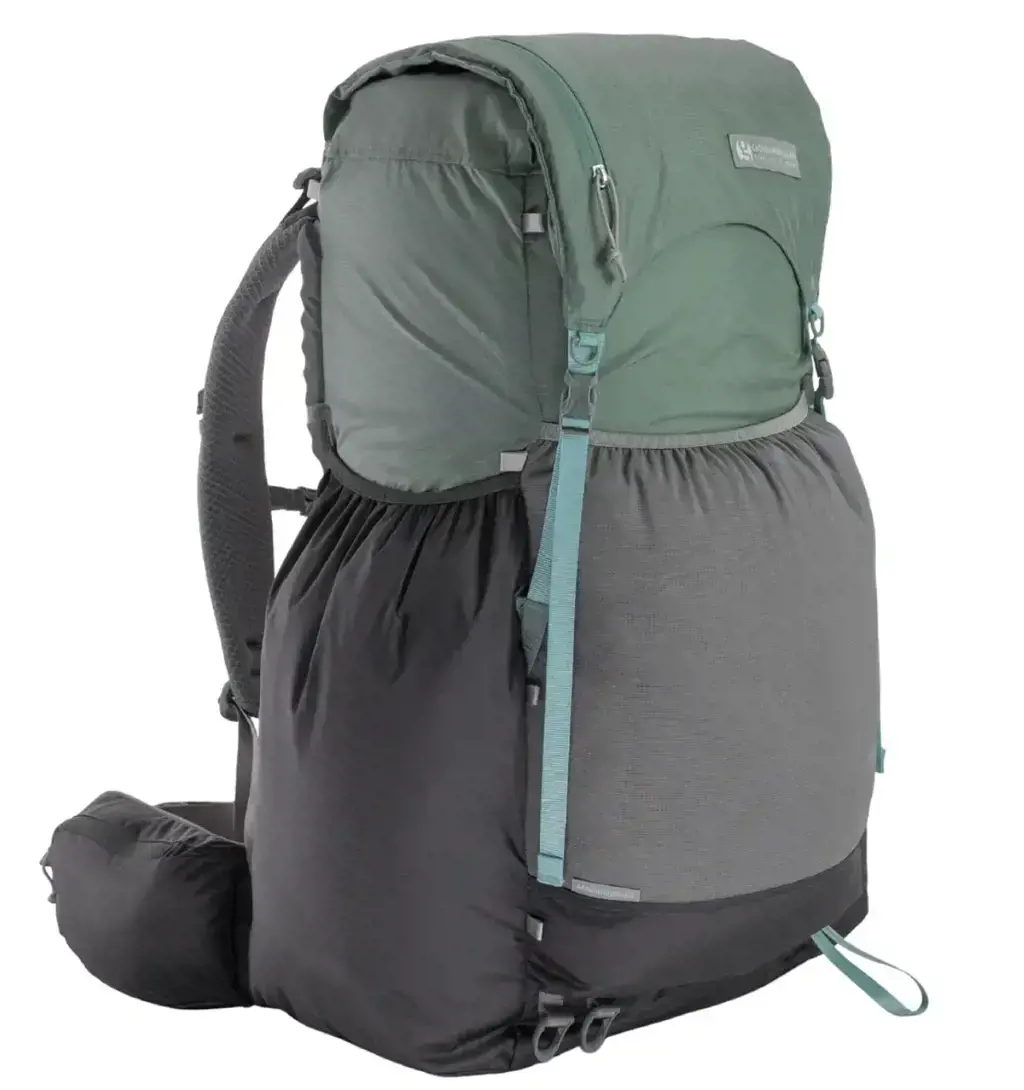
When embarking on a thru-hike of the Appalachian Trail, choosing the right pack is crucial. Thru-hikers, who aim to complete the entire 2,190-mile trail in one go, need a pack that is lightweight, durable, and comfortable. Over the years, a few pack brands and models have emerged as favorites among Appalachian Trail thru-hikers.
One popular brand among thru-hikers is Osprey. Osprey packs are known for their durability, comfort, and innovative design features. The Osprey Exos and Eja packs are particularly popular among hikers due to their lightweight construction and ventilated back panels, which help keep hikers cool and reduce sweating. These packs also have ample storage space and multiple pockets for organizing gear.
Another highly recommended pack brand is Granite Gear. The Granite Gear Crown2 is a favorite among thru-hikers due to its exceptional weight-to-capacity ratio. It is a lightweight pack that can comfortably carry heavy loads, thanks to its supportive suspension system. The Crown2 also features a customizable fitting system, allowing hikers to adjust the pack to their specific body shape and size.
The Hyperlite Mountain Gear (HMG) packs are also gaining popularity among thru-hikers. HMG specializes in ultralight backpacks made from Dyneema Composite Fabric, a durable and waterproof material. The HMG packs are known for their minimalist design, light weight, and robust construction. However, they come with a higher price tag compared to other pack brands.
In addition to these brands, individual models within these brands are highly regarded within the thru-hiking community. For example, the Osprey Atmos and Aether packs are also popular choices among hikers who prefer a more traditional backpacking pack with additional features and support. On the other hand, the Granite Gear Blaze pack is often favored by hikers who require a larger capacity for extended journeys.
While these packs are popular choices among thru-hikers, it's important to note that there is no one-size-fits-all solution. Each hiker has unique preferences and needs, and it's essential to try on and test different packs before making a final decision. Factors such as body shape, weight distribution, and personal comfort play a significant role in determining the right pack for an individual.
Thru-hiking the Appalachian Trail is a challenging endeavor, and having a well-fitting and reliable pack is essential for a successful hike. By researching and trying out different pack brands and models, hikers can find the perfect pack that meets their specific needs and preferences.
Packing Tips for The Washington Center: How to Prepare for Your Program
You may want to see also
Frequently asked questions
The size of the pack you need for thru-hiking the Appalachian Trail depends on your personal preferences and needs. However, most experienced hikers recommend using a pack with a capacity of around 50-65 liters. This size should provide enough space to carry all the necessary gear and supplies for a long-distance hike while still remaining comfortable to carry.
It is generally recommended to have a pack that is on the smaller side for thru-hiking the Appalachian Trail. A smaller pack can help keep your overall load lighter and more manageable, which is especially important when hiking long distances day after day. It also encourages you to pack more efficiently and prioritize only the essential items, helping to reduce unnecessary weight.
To determine the right size pack for the Appalachian Trail, you should consider the length of your hike, the amount of gear and supplies you plan to carry, and your personal comfort preferences. It can be helpful to make a list of all the items you plan to bring and estimate their volume. Additionally, you may want to try on different pack sizes and load them with some weight to see how they feel on your back. Remember that the best pack for you is one that fits properly and feels comfortable to carry for long periods.
It is possible to use a backpack you already own for thru-hiking the Appalachian Trail, but you should carefully consider its size and features. Make sure it has enough capacity to hold all your gear and supplies without being overly packed or bulging. It should also have a supportive and adjustable suspension system to ensure a proper fit and distribute the weight evenly. If your current backpack meets these criteria, you may not need to invest in a new one. However, if it falls short in any aspect, it may be worth considering purchasing a new pack designed specifically for thru-hiking.
When shopping for a thru-hiking backpack, there are a few key features to look for. Firstly, make sure the pack has a supportive and adjustable suspension system to ensure a comfortable fit. Look for a pack with multiple pockets and compartments for organizing your gear and easy access to essentials. Consider the overall weight of the pack, as a lighter pack can make a significant difference when hiking long distances. Finally, check for features such as a water bottle holder, a hydration bladder sleeve, and attachment points for trekking poles or ice axes, depending on your needs.







